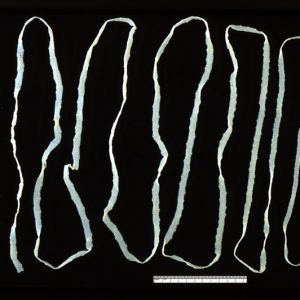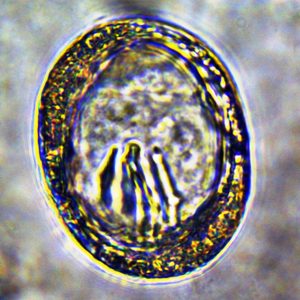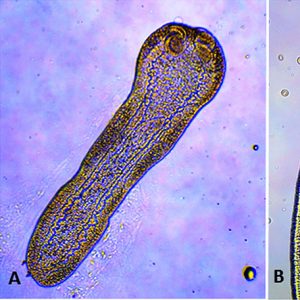calsfoundation@cals.org
Cestodes
aka: Tapeworms
Cestodes (tapeworms) include flatworms belonging to the phylum Platyhelminthes, class Cestoidea, subclasses Cestodaria (two orders) and Eucestoda (sixteen orders), and about fifty-nine families. The subclass Cestodaria includes monozoic (unsegmented) tapeworms containing only a single set of male and female reproductive organs; these are parasitic in the intestinal tract and body cavity of fishes and turtles. The subclass Eucestoda is made up of polyzoic (segmented) or monozoic cestodes of varying structure and parasitic in the intestines of vertebrates. To date, there are more than 5,000 described species that, as endoparasites, infect all vertebrate classes. The classification of tapeworms remains ambiguous using classical morphological studies alone, and, although some studies have been done recently using molecular tools, further attention is needed to help clarify their taxonomy. Numerous cestodes infect wild and domestic vertebrates in Arkansas, including, but not limited to, those in the genera Anoplocephala, Bothriocephalus, Corallobothrium, Davainea, Dipylidium, Echinococcus, Hymenolepis, Mesocestoides, Moniezia, Oochoristica, Paranoplocephala, Proteocephalus, Spirometra, and especially Taenia.
The modern scientific study of the human taeniid tapeworms of humans can be traced to the late seventeenth century and the observations of Edward Tyson (1651–1708). He was the first to recognize the important taxonomic structure called the scolex (head) of a tapeworm, and Tyson’s subsequent descriptions laid the foundations for knowledge of the biology of human taeniid tapeworms. In 1758, Carolus Linnaeus (1707–1778) in the tenth edition of Systema Naturae, described and named the pork tapeworm, Taenia solium, and broad-fish tapeworm, Taenia lata (=Diphyllobothrium latum). In 1784, the first indications that intermediate hosts were involved in the life cycles of taeniid tapeworms emerged from the detailed studies of T. solium by Johann August Ephraim Goeze (1731–1793), who observed that the heads of the tapeworm in humans resembled cysts in the musculature of swine.
Gottlieb Heinrich Friedrich Küchenmeister (1821–1890), in heavily criticized experiments, but with the approval of prison officials, fed pig meat (sausage) containing the cysticerci (bladderworms) of T. solium to criminals condemned to death and recovered adult tapeworms from their intestines after they had been executed. In 1868, J. H. Oliver observed that T. saginata tapeworm infections occurred in individuals who had eaten “measly” beef, and this was confirmed in 1877 by Edoardo Perroncito (1847–1936). The twentieth and twenty-first centuries have witnessed numerous advances in the study of tapeworms.
Most species of eucestode tapeworms are polyzoic (those of the order Caryophyllidea are not), and all lack a digestive system. Therefore, they must absorb all their nutrients through the body covering. The body (or strobilus) of most tapeworms consists of individual segments termed proglottids. Tapeworms are hermaphroditic—that is, each proglottid typically consists of both male and female reproductive organs, similar to those found in the digenetic trematodes, with the exception of Schistosoma spp. and similar worms. Growth of a new strobila (a process called strobilation) occurs in the neck region, more or less continually during the life of most species, and each proglottid moves toward the posterior end as a new one takes its place during maturation. In a sexually mature adult tapeworm, the proglottids at the posterior end have matured to contain both testes and ovaries, copulated (either with themselves, with other proglottids in the strobila, or with those of other worms), and produced ova (eggs).
After a proglottid contains fully developed shelled embryos, it is termed gravid. Proglottids detach and pass out of the body of the host with the feces, often rupturing before exiting the host. Many tapeworms have a head at the anterior end that can be equipped with various holdfast organs (grooves, hooks, suckers, spines, glands, tentacles, or any combination of structures) to maintain its position within the mucosa of the host gut. Some have an extendable, dome-shaped area on the top of the head termed the rostellum, which often has one to two rows of hooks.
With rare exceptions, the life cycle of cestodes is usually indirect. For those infecting humans, adults live in the intestinal tract and generally have one of two basic strategies. The first is an aquatic life cycle, often involving three host life cycles, with the eggs usually being shed unembryonated (and usually in the water); a six-hooked larval stage (hexacanth) termed a coracidium eventually develops. The coracidium is composed of an oncosphere (embryo) and inner ciliated envelope. Once mature, the coracidium emerges and is then eaten by an aquatic arthropod (usually some sort of crustacean). Sometimes, the entire egg containing the coracidium is eaten, and the larva hatches within the digestive tract of an arthropod. The coracidium casts off its inner ciliated layer, the oncosphere crosses the gut wall, metamorphosis occurs, and a new larval stage termed a procercoid develops. The hooks of the hexacanth larva migrate posteriorly during maturation of the procercoid and become incorporated into a posterior structure termed a cercomer.
When this infected arthropod is eaten by the second intermediate host (usually a fish), the procercoid penetrates the intestine, migrates to the skeletal muscle, and develops into a plerocercoid. The plerocercoid is elongate, has a scolex, and often has some degree of strobilation. Plerocercoids can generally be passed paratenically (accidentally) from host to host through predation. If the second intermediate host is eaten by the appropriate vertebrate final host, the worm attaches to the intestinal epithelium and develops into an adult. Examples are the pseudophyllidean and a few tetraphyllidean tapeworms, some of which are found in humans and other mammals but also infect fishes, amphibians, reptiles, and birds.
The other strategy, in a terrestrial life cycle, is typical of cyclophyllideans where there is neither a procercoid or plerocercoid stage; rather, it generally involves two host life cycles, and the eggs are usually passed out of the host fully embryonated. After being ingested by an appropriate host (arthropod or herbivore), the onchosphere penetrates the gut and develops into a larval stage somewhere within the tissues or coelomic cavity. This stage may be a cysticercoid (solid body, invaginated, often in arthropods) or cysticercus (scolex on germinative membrane enclosing a fluid-filled bladder, invaginated, introverted). It has a solid body with a fully developed scolex invaginated into its body. This type of larval stage is characteristic of Hymenolepis spp., both of which have a coenurus (few to many scolices, termed protoscolices, that arise from the germinative membrane of the cyst, each with a simple stalk invaginated into the common bladder as in Taenia multiceps); this is capable of infecting humans.
There are several types of cysticerci besides the simple type, such as the coenurus, unilocular hydatid cyst (up to several million protoscolices with endogenous budding of brood cysts as in the cyclophyllidean genus Echinococcus), and multilocular hydatid cysts (extensive exogenous budding in abnormal hosts resulting in infiltration of tissues like a cancer, as in Echinococcus multilocularis). Following ingestion of the larval stage by the appropriate final host, the worm will begin growth and mature. These juvenile stages are of considerable medical and veterinary importance, and examples include the cyclophyllidean tapeworms, which are parasites of amphibians, reptiles, birds, and mammals, including humans.
Some tapeworms of human importance include the pseudophyllidean tapeworm, Diphyllobothrium latum. Common in fish-eating carnivores, it can reach lengths up to ten meters. The broad-fish tapeworm is native to the Baltic states, western Russia, and Scandinavia, although it is now also present in North America, especially the Pacific Northwest. It may infect a variety of mammals, including humans. It is thought to infect up to nine million people worldwide. Interestingly, this tapeworm apparently infected native South Americans before Christopher Columbus arrived in the New World in the late fifteenth century. The life cycle involves a copepod first intermediate host, a fish second intermediate host, and the numerous examples of definitive hosts listed above. Eating undercooked fish or raw salmon or sashimi in sushi restaurants in the United States has led to infections of D. latum.
The rat tapeworm, Hymenolepis diminuta, is generally found in rats, but human infections are not uncommon; it can reach up to ninety centimeters in length and possesses four suckers and a rostellum, but without hooks. The proglottids have unilateral genital pores and three testes per proglottid. More than ninety species of arthropods can serve as suitable intermediate hosts, especially stored grain beetles.
Another of human importance is the dwarf tapeworm, Vampirolepis nana (=Hymenolepis nana or Rodentolepis nana), one of the most common tapeworms infecting humans in the world. Infection rates vary from about one percent in the southern United States to nine percent in Argentina and ninety-seven percent in Russia. This species has twenty to thirty hooks on the head, whereas H. diminuta does not. It measures up to forty millimeters in length and has a long, slender neck. The proglottids are wider than long, the genital pores are unilateral, and there are three testes per segment. It is likely this species actually consists of cryptic species (a complex of many morphologically similar species), as nearly indistinguishable specimens are commonly found in rodents and other animals worldwide. The life cycle is unique among cestodes as intermediate hosts are optional—that is, eggs swallowed by a definitive host (mice, rats, humans) hatch in the duodenum, and oncospheres penetrate the intestinal villi. Fortunately, pathological problems are rare and only occur with massive infections that can be easily treated.
Another important group of human tapeworms belong to the genus Taenia and include T. solium and the beef tapeworm (Taenia saginata), both causing taeniasis from eating raw or undercooked pork or beef, respectively. The former tapeworm, which has been recognized since biblical times, is a very dangerous pathogen of humans and can lead to death from neurocysticercosis of the brain. It is possible to infect other family members in the same household with juveniles (Cysticercus cellulosae) of this tapeworm, often with serious results. Treatment of symptomatic neurocysticercosis is with corticosteroids, anticonvulsants, and, in some situations, Albenza (albendazole) or praziquantel. Surgery may be required in extreme cases of neurocysticercosis that do not respond to drugs, but adult worms elsewhere can be eradicated with praziquantel. In other anatomical areas, cysticerci can infect virtually every organ and tissue in the human body, including the muscles, heart, liver, lungs, eyes, and coelom. For example, ocular cysticercosis may cause damage to the retina, iris, or choroid if not surgically removed.
Adult taeniid tapeworms may reside in the small bowel for years. They reach two to seven meters in length and produce up to 1,000 proglottids; each contains about 50,000 eggs. Insects such as blowflies are known to carry eggs from infected feces to uninfected meat, which is eaten by pigs—and pigs also feed on human feces.
Adult members of the genus Echinococcus are small (3–8 millimeters) tapeworms that are capable of infecting humans, causing echinococcosis or hydatid disease (hydratidosis), a serious disease in many areas of the world. One species, Echinococcus granulosus, uses carnivores (especially dogs and other canines) as definitive hosts, with many other mammals as intermediate hosts. The adult worm resides in the small intestine of the definitive host with the onchosphere, developing into an unilocular hydatid called a bladderworm in the lungs and liver of an intermediate host (usually a sheep or another herbivore) that was infected from eating herbage contaminated with dog feces. Humans become infected with massive bladder-like hydatid cysts when accidentally ingesting Echinococcus eggs, usually because of close contact with dogs.
A common cosmopolitan parasite of veterinary importance in dogs and cats is the double-pored dog tapeworm, Dipylidium caninum; it also occurs in humans (mostly children). It is an easily recognizable tapeworm because of the characteristic two sets of male and female reproductive structures and a genital pore on each side of the proglottids. The usual intermediate hosts are fleas, although chewing lice are also known to be hosts. When a flea or louse is licked or nipped out of the fur of the host and swallowed, the life cycle is completed. Although adult cases have been reported rarely, nearly every other human infection of D. caninum has involved children. Pathology and treatment are similar to those of H. nana.
An enigmatic tapeworm genus is Mesocestoides, which, as adults, are parasites of birds and carnivorous mammals. The life cycle has never been conclusively demonstrated; however, it is believed to require at least three hosts (i.e., a vertebrate definitive host, a vertebrate second intermediate host, and a supposed arthropod first intermediate host). Encapsulated and free metacestodes known as tetrathyridia are often found in the body cavity and various organs of amphibians, reptiles, and rodents, with carnivores (both birds and mammals) serving as definitive hosts. Neither reptiles nor mammals can be infected directly by eggs, so a first intermediate host must be involved and, as yet, has never been identified. This is an interesting genus in other ways, as some species may undergo asexual multiplication in the host by longitudinal division of the scolex. Although most often reported from other vertebrates, human infections have been reported mainly in Japan. This genus has been studied extensively in numerous amphibians and reptiles in Arkansas.
Caryophyllidean tapeworms of freshwater teleost fishes and annelid worms are generally less than ten centimeters long and possess an unspecialized scolex or one with shallow grooves or loculi (shallow sucker-like depressions) or shallow bothria (dorsal or ventral groove). In addition, tapeworms in this order have a single proglottid, which is believed to be the primitive condition for cestodes. In the life cycle, adults occur in the intestinal tract of fishes, which pass the eggs in their feces. Annelids feed on the eggs, where they hatch into oncosphere larvae that move through the intestinal wall and become a procercoid in the body cavity. When the annelid is eaten by a fish, the tapeworm matures. These tapeworms are common in catostomid (sucker) fishes, catfishes, and some minnows. To date, none have been reported from fishes in Arkansas, although several are known from the surrounding states of Missouri, Oklahoma, Tennessee, and Texas.
In Arkansas, there is another noteworthy tapeworm, this one a nuisance species found in freshwater aquaculture. The Asian fish tapeworm, Bothriocephalus acheilognathi, originated in eastern Russia and China and made its way to North America and Arkansas in the mid-1970s in cyprinid fishes, particularly live grass carp, Ctenopharyngodon idella. It was also transferred from Arkansas to Florida in grass carp and golden shiners, Notemigonus crysoleucas, soon thereafter. This species is easily recognized by the heart-shaped head. An accumulation of these tapeworms in the bile duct of fishes can lead to blockage that distends the intestinal wall, leading to perforation. When attached, B. acheilognathi induces an inflammatory response that can result in hemorrhage and necrosis. Symptoms can also include weight loss, anemia, and ultimately, death, especially in young fishes. The life cycle of B. acheilognathi involves a fish definitive host and a copepod intermediate host. Research has documented that B. acheilognathi decreases the size of fish worldwide, causing great economic losses in hatcheries and fish farms.
There are multiple chemotherapeutic solutions to fight infection. Pharmaceuticals mixed in fish food with vegetable oil—such as dibutyltin dilaurate (Tinostat), niclosamide (Yomesan) and praziquantel (Droncit)—are effective in relieving infections in fish tanks. Eliminating an infection before it begins can be done by controlling copepods in waters where fishes are cultured with organophosphates or by obtaining parasite-free stocks of fishes.
A new species of linstowiid tapeworm, Oochoristica crotaphyti, was described from collared lizards, Crotaphytus collaris, from Arkansas. The type locality is near Calico Rock (Izard County), and additional tapeworms were found in collared lizards from Baxter and Stone counties. The life cycle is unknown but is thought to include some type of arthropod intermediate host, since all life cycles in the genus have been shown to use insects.
For additional information:
Ashford, Richard W., and William Crewe. The Parasites of Homo sapiens. London: Taylor & Francis, 2003.
Caira, Janine N., Kirsten Jensen, Andrea Waeschenbach, P. D. Olson, and D. T. J. Littlewood. “Orders Out of Chaos—Molecular Phylogenetics Reveals the Complexity of Shark and Stingray Tapeworm Relationships.” International Journal for Parasitology 44 (2014): 55–73.
Coombs, Isabel, and David W. T. Crompton. A Guide to Human Helminthology. London: Taylor & Francis, 1991.
Cox, Frank E. G. “History of Human Parasitology.” Clinical Microbiology Reviews 15 (2002): 595–612.
Foster, W. D. A History of Parasitology. Edinburgh: E. & S. Livingston, 1965.
Mackiewicz, John S. “Caryophyllidea (Cestoidea): A Review.” Experimental Parasitology 31 (1972): 417–512.
Mehlhorn, Heinz, ed. Encyclopedia of Parasitology. 3rd ed. New York: Springer International Publishing, 2008 (4th ed., 2016).
McAllister, Chris T., Charles R. Bursey, Steve J. Upton, Stanley E. Trauth, and David B. Conn. “Parasites of Desmognathus brimleyorum (Caudata: Plethodontidae) from the Ouachita Mountains of Arkansas and Oklahoma.” Journal of the Helminthological Society of Washington 62 (1995): 150−156.
McAllister, Chris T., and David B. Conn. “Occurrence of Mesocestoides sp. Tetrathyridia (Cestoidea: Cyclophyllidea) in North American anurans (Amphibia).” Journal of Wildlife Diseases 26 (1990): 540−543.
McAllister, Chris T., David B. Conn, and Stanley E. Trauth. “Tetrathyridia of Mesocestoides lineatus (Cestoidea: Cyclophyllidea) in Sceloporus undulatus hyacinthinus (Sauria: Iguanidae), from Arkansas.” Journal of the Helminthological Society of Washington 59 (1992): 241–243.
McAllister, Chris T., Matthew B. Connior, and Stanley E. Trauth. “New Host Records for Mesocestoides sp. tetrathyridia (Cestoidea: Cyclophyllidea) in Anurans (Bufonidae, Ranidae) from Arkansas, with a Summary of North American Amphibian Hosts.” Journal of the Arkansas Academy of Science 68 (2014): 158–162.
McAllister, Chris T., Matthew B. Connior, Charles R. Bursey, Stanley E. Trauth, Henry W. Robison, and David B. Conn. “Six New Host Records for Mesocestoides sp. Tetrathyridia (Cestoidea: Cyclophyllidea) from Amphibians and Reptiles of Arkansas, U.S.A.” Comparative Parasitology 81 (2014): 278–283.
McAllister, Chris T., Stanley E. Trauth, and Michael V. Plummer. “A New Host Record for Mesocestoides sp. (Cestoidea: Cyclophyllidea: Mesocestoididae) from a Rough Green Snake Opheodrys aestivus (Ophidia: Colubridae) in Arkansas, U.S.A. “ Comparative Parasitology 80 (2013): 130–133.
McAllister, Chris T., Stanley E. Trauth, and John E. Ubelaker. “Oochoristica crotaphyti n. sp. (Eucestoda: Linstowiidae) from Crotaphytus collaris (Lacertilia: Iguanidae) in Northern Arkansas.” Journal of Parasitology 71 (1985): 803–807.
Parasitology Global Cestode Database. University of Connecticutt. http://www.tapeworms.uconn.edu/index.html (accessed September 7, 2021).
Roberts, Larry S., and John Janovy Jr. Foundations of Parasitology. 9th ed. Boston: McGraw-Hill Higher Education, 2012.
Schmidt, Gerald D. Handbook of Tapeworm Identification. Boca Raton: CRC Press, 1986.
Smyth, John D., and D. P. McManus. The Physiology and Biochemistry of Cestodes. Cambridge: Cambridge University Press, 2007.
Wardle, Robert A., James A. McLeod, and Sydney Radinovsky. Advances in the Zoology of Tapeworms, 1950–1970. Minneapolis: University of Minnesota Press, 1974.
Chris T. McAllister
Eastern Oklahoma State College









Comments
No comments on this entry yet.